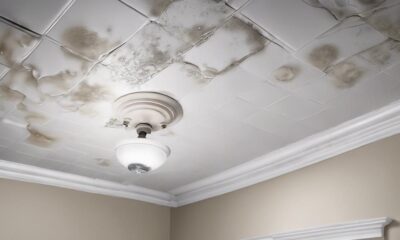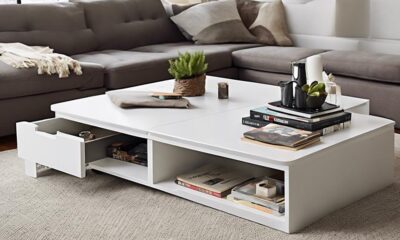Plants
Efficient Fruit Fly Trap Solutions for Your Home

Fruit flies can quickly become a nuisance in your home, especially if you have ripe, rotting fruit or other food sources that they are attracted to. Luckily, there are plenty of efficient fruit fly trap solutions that you can try to keep your home pest-free.
From homemade traps using apple cider vinegar, old wine, or beer, to natural bait options and DIY methods, we’ve got you covered. With these effective fruit fly trap solutions, you can get rid of those pesky fruit flies and prevent future infestations.
Key Takeaways:
- Make homemade traps using apple cider vinegar, old wine, or beer to lure and trap fruit flies.
- Explore natural bait options and DIY methods for fruit fly control.
- Prevent future fruit fly infestations by practicing proper sanitation and hygiene.
- Consider purchasing pre-made fruit fly traps for convenience and effectiveness.
- Combine traps with other preventative measures to enhance fruit fly control in your home.
What are fruit flies?
Fruit flies are small insects that are attracted to ripe, rotting, or decayed fruit and produce, as well as fermented goods like beer, liquor, and wine. These pests can quickly lay hundreds of eggs on overripe produce, leading to a maggot infestation. Fruit flies are usually light or dark brown in color with red eyes. Identifying fruit flies correctly is essential for effectively getting rid of them.
“Fruit flies are small insects that are attracted to ripe, rotting, or decayed fruit and produce, as well as fermented goods like beer, liquor, and wine.”
What causes fruit fly infestations indoors?
Fruit fly infestations indoors are typically caused by the presence of ripe, rotting, or decaying fruit and produce, as well as fermented goods. Fruit flies are naturally attracted to the scent of fermentation, and they can quickly reproduce, leading to an infestation in your home. To effectively prevent fruit fly infestations, it’s crucial to eliminate potential food sources and breeding grounds.
In the following table, we have listed some common factors that contribute to indoor fruit fly infestations:
| Potential Causes | Prevention Measures |
|---|---|
| Presence of ripe and decaying fruits | – Consume fruits before they become overripe – Store ripe fruits in the refrigerator – Promptly dispose of rotting or spoiled fruits |
| Uncovered or exposed food waste | – Ensure kitchen surfaces and trash cans are clean and dry – Seal and dispose of garbage regularly – Clean spills and crumbs immediately |
| Fermented goods like beer, wine, or vinegar | – Keep beverage containers tightly sealed – Clean up any spills or drips – Dispose of old or expired bottles |
| Homegrown or outdoor produce | – Inspect fruits and vegetables for signs of infestation before bringing them indoors – Rinse produce thoroughly before consumption – Store harvested fruits and veggies properly |
| Fruit fly breeding grounds | – Clean drains regularly to remove buildup – Cover drains with mesh screens – Remove any standing water sources |
By being proactive and following these prevention measures, you can significantly reduce the risk of fruit fly infestations in your home.
How to Prevent Future Fruit Fly Infestations
To prevent fruit fly infestations from plaguing your home, it’s crucial to take proactive measures and establish good hygiene practices. By implementing the following steps, you can significantly reduce the risk of fruit fly infestations in the future:
- Dispose of overripe produce: Regularly check and discard any fruits or vegetables that have become overripe or started to decay. Fruit flies are attracted to the smell of rotting produce, so removing this food source is essential in preventing infestations.
- Store fruits and vegetables properly: Place ripe fruits and vegetables in the refrigerator to keep them fresh for longer. This helps minimize the odors that can attract fruit flies and keeps them out of reach.
- Wash produce immediately: Upon bringing home fruits and vegetables, thoroughly wash them before storing or consuming. This helps eliminate any eggs or larvae that may be present.
- Regularly empty the garbage: Dispose of trash and organic waste regularly to discourage fruit flies from breeding in the garbage bin. Seal the garbage bag tightly and dispose of it outside your home as soon as it’s full.
- Clean up spills promptly: Fruit flies are also attracted to sugary and sticky substances. Wipe up any spills, particularly those involving fruit juices or sweet beverages, to prevent a possible fruit fly infestation.
By diligently following these preventive measures, you can significantly reduce the presence of fruit flies in your home and enjoy a pest-free environment.
Additional Tips for Fruit Fly Control:
Aside from the preventive steps mentioned above, here are a few additional tips to further enhance your fruit fly control efforts:
- Maintain good overall hygiene: Make sure to clean your kitchen regularly, paying attention to areas where food particles may accumulate, such as countertops, sinks, and drains.
- Inspect incoming produce: Before bringing fruits and vegetables into your home, inspect them for any signs of damage or infestation. This will help prevent introducing fruit flies unknowingly.
- Use screens on windows and doors: Installing screens on windows and doors can effectively keep fruit flies and other flying insects from entering your home.
- Consider using natural repellents: Some essential oils, such as lemongrass, mint, or lavender, are known to repel fruit flies. Consider using these natural repellents in your kitchen or near potential entry points to deter fruit flies.
By combining these additional tips with proper sanitation and the preventive measures mentioned earlier, you can establish a comprehensive approach to fruit fly control and enjoy a fruit fly-free home.
How to trap and kill fruit flies, fast
When it comes to dealing with fruit flies in your home, quick and effective trapping and killing methods are essential. Luckily, there are several homemade traps that you can easily make to get rid of these pesky pests.
Apple cider vinegar trap: Fruit flies are highly attracted to the sweet scent of apple cider vinegar. To create this trap, fill a small bowl or jar with apple cider vinegar and cover it tightly with plastic wrap. Use a fork or toothpick to poke a few small holes in the plastic wrap. The fruit flies will be lured by the scent of the vinegar, enter through the holes, but won’t be able to find their way out.
Paper cone trap: Another effective method is the paper cone trap. Take a piece of paper and roll it into a cone shape, leaving a small opening at the tip. Place some vinegar and a small piece of old fruit at the bottom of a jar or bottle. Insert the paper cone into the jar or bottle, making sure it fits snugly. The fruit flies will be attracted to the rotting fruit and vinegar, but the narrow opening of the cone will make it difficult for them to escape.
Vinegar and dish soap trap: This trap is incredibly simple yet effective. Fill a small bowl or jar with vinegar and add a few drops of dish soap. The dish soap breaks the surface tension of the vinegar, causing the fruit flies to sink and drown when they come in contact with the solution.
You can also opt for pre-made fruit fly traps that are available for purchase. These traps are designed with specific lures and sticky surfaces to attract and capture fruit flies effectively. They are convenient and can be placed in various areas of your home where fruit flies tend to gather.
Remember, when implementing fruit fly traps, it’s important to place them near areas where fruit flies are commonly found, such as near fruits, trash cans, or drains. Regularly check and empty the traps to ensure their efficiency in trapping and killing fruit flies.
Can I use bleach to kill fruit flies?
When dealing with a fruit fly infestation, it’s natural to wonder if bleach can be used as a solution. While bleach does have some effectiveness in killing fruit fly larvae, it is not the most efficient method for getting rid of fruit flies entirely. The main issue with using bleach is that it tends to pass down the drain too quickly to thoroughly eliminate the eggs and larvae.
Instead of relying solely on bleach, it is recommended to focus on practicing proper sanitation and using fruit fly traps to effectively control and eliminate fruit flies. Here at [Brand Name], we have found that a combination of these methods yields the best results in fruit fly eradication.
Using fruit fly traps such as those discussed in previous sections can help capture adult flies, preventing them from laying eggs and perpetuating the infestation. By eliminating the breeding adults, you can stop the cycle of fruit fly reproduction and reduce their population in your home.
So while bleach may have some impact on fruit fly larvae, it is not the ideal solution for complete fruit fly control. Implementing proper sanitation practices and utilizing fruit fly traps will provide a more effective and long-lasting solution to your fruit fly problem.
For more guidance on getting rid of fruit flies and preventing future infestations, continue reading the other sections of our comprehensive guide.
Expert Tip: Focus on sanitation and traps
“To effectively control and eliminate fruit flies, it’s essential to focus on proper sanitation and using the right traps. While bleach may kill some larvae, it won’t solve the overall infestation problem. By combining good hygiene practices and effective traps, you can achieve long-term fruit fly control.”
How do I kill fruit flies outdoors?
If you have fruit flies buzzing around your homegrown fruits and vegetables outdoors, we have a solution for you. You can use Spinosad insecticide to kill those stubborn pests.
Here’s how to use Spinosad to get rid of fruit flies:
- Fill a garden sprayer with the Spinosad solution.
- Apply the insecticide around the base of your home and directly onto your fruits.
- By spraying the solution, you can eliminate any fruit flies that may have landed on your produce or are lingering around your outdoor space.
Remember, it’s crucial to rinse your fruits and vegetables thoroughly before consuming them to remove any residue from the insecticide. Safety should always come first!
Now you can enjoy your homegrown fruits and vegetables without the annoyance of fruit flies.
The Best Fruit Fly Trap Solutions You Can Buy
In addition to homemade traps, there are also many commercial fruit fly trap solutions available for purchase. These traps are designed to attract and capture fruit flies effectively. Some highly-rated products include:
| Product | Description | Image |
|---|---|---|
| Catchmaster Clear Window Fly Trap | A transparent sticky trap that can be easily placed on windows to capture fruit flies. | |
| Garsum Stick Fly Trap | A stick trap coated with a strong adhesive that can attract and trap fruit flies. | |
| Cape Sundew (a carnivorous plant) | A unique plant that attracts and captures fruit flies with its sticky leaves. | |
| Katchy Indoor Insect Trap | An electric insect trap that uses UV light and a sticky surface to catch fruit flies. | |
| Terro Fruit Fly Trap | A non-toxic trap that uses a liquid lure to attract and trap fruit flies. | |
| FlyFix Fruit Fly Trap | A decorative trap that uses a liquid bait to attract and trap fruit flies. | |
| RSVP Endurance Fruit Fly Trap | A stainless steel trap that uses a liquid lure to attract and trap fruit flies. |
These traps offer different methods of trapping and killing fruit flies, providing you with options to find the best solution for your needs. Whether you prefer a transparent window trap, a stick trap, a carnivorous plant, or an electric insect trap, there’s a fruit fly trap out there that can help you effectively eliminate these pests from your home.
Additional Tips for Fruit Fly Control
In addition to using fruit fly traps, there are other measures you can take to enhance your fruit fly control efforts. By implementing these additional tips, you can prevent and eliminate fruit fly infestations in your home.
1. Store fruits and veggies in the fridge
Storing fruits and vegetables in the fridge helps to keep them fresh for longer and minimizes the chances of fruit fly infestations. Make sure to remove any overripe or damaged produce from your fruit bowl or countertop and store them in a sealed container or refrigerator.
2. Wash produce when bringing it home
Washing your fruits and vegetables as soon as you bring them home can remove any fruit fly eggs or larvae that may be present on the surface. Use water and a mild detergent or produce wash to thoroughly cleanse your produce before storing or consuming it.
3. Practice good kitchen hygiene
Avoid leaving dirty dishes in the sink for too long, as they can attract fruit flies. Make it a habit to clean your sink drains and garbage disposal regularly to remove any food residue that could attract fruit flies. Additionally, emptying the trash frequently prevents any ripe, decaying items from becoming a breeding ground for fruit flies.
4. Maintain overall cleanliness
Maintaining a clean and tidy home helps to minimize the chances of fruit fly infestations. Wipe down countertops, clean up any spills or food crumbs immediately, and keep your kitchen and other areas where fruit flies tend to gather as clean as possible.
Implementing these additional tips along with using fruit fly traps will significantly improve your ability to control and prevent fruit fly infestations in your home. By being proactive and attentive to sanitation and hygiene practices, you can enjoy a pest-free environment and keep those pesky fruit flies at bay.
Conclusion
Fruit fly infestations can be frustrating, but with the right fruit fly trap solutions and preventative measures, you can effectively control and eliminate them from your home. Homemade traps using apple cider vinegar, paper cones, or plastic bottles can be highly effective in trapping and killing fruit flies. Additionally, there are pre-made traps available for purchase that offer different trapping methods. By combining these traps with proper sanitation and hygiene practices, you can successfully prevent and eliminate fruit fly infestations, keeping your home pest-free. Yes, snake plants can help keep fruit flies away from your home. In addition to their benefits for snake plant health and aesthetics, these plants release oxygen at night, which can deter fruit flies. Their strong scent also repels these pesky insects, making them a natural and attractive solution for your home. Some effective fruit fly trap solutions include homemade traps using apple cider vinegar, old wine, or beer, natural bait options, and DIY methods. There are also pre-made fruit fly traps available for purchase. Fruit flies are small insects that are attracted to ripe, rotting, or decayed fruit and produce, as well as fermented goods like beer, liquor, and wine. They can quickly lay hundreds of eggs on overripe produce, leading to a maggot infestation. Fruit fly infestations indoors are caused by the presence of ripe, rotting, or decaying fruit and produce, as well as fermented goods. Fruit flies are attracted to the scent of fermentation and can quickly reproduce, leading to an infestation. To prevent future fruit fly infestations, it’s important to practice proper sanitation and hygiene in your home. This includes throwing out overripe produce, storing fruits and vegetables in the fridge, washing produce as soon as you bring it home, taking out the garbage regularly, and cleaning up spills promptly. There are various homemade traps and methods that you can use to trap and kill fruit flies in your home. Effective methods include using apple cider vinegar and plastic wrap, a paper cone and vinegar with old fruit, or vinegar with dish soap. Additionally, there are pre-made fruit fly traps available for purchase. While bleach may kill some fruit fly larvae, it is not the most effective solution for getting rid of fruit flies. It is recommended to focus on practicing proper sanitation and using fruit fly traps to effectively control and eliminate fruit flies. If you have fruit flies buzzing around your homegrown fruits and vegetables outdoors, you can use Spinosad insecticide to kill them. It is important to rinse your fruits and vegetables before consuming them to remove any residue from the insecticide. Some highly-rated commercial fruit fly trap solutions include the Catchmaster Clear Window Fly Trap, Garsum Stick Fly Trap, Cape Sundew (a carnivorous plant), Katchy Indoor Insect Trap, Terro Fruit Fly Trap, FlyFix Fruit Fly Trap, and RSVP Endurance Fruit Fly Trap. In addition to using fruit fly traps, other measures you can take to control and prevent fruit fly infestations include storing fruits and veggies in the fridge, washing produce when you bring it home, not leaving dirty dishes in the sink, cleaning your sink drains and garbage disposal regularly, emptying the trash frequently, and maintaining good overall hygiene in your home. By using fruit fly trap solutions, practicing proper sanitation, and implementing additional tips for fruit fly control, you can effectively control and eliminate fruit fly infestations in your home, keeping it pest-free.Can Snake Plants Help Keep Fruit Flies Away from My Home?
FAQ
What are some efficient fruit fly trap solutions for my home?
What are fruit flies?
What causes fruit fly infestations indoors?
How can I prevent future fruit fly infestations?
How can I trap and kill fruit flies quickly?
Can I use bleach to kill fruit flies?
How do I kill fruit flies outdoors?
What are the best fruit fly trap solutions I can buy?
What are some additional tips for fruit fly control?
How can I effectively control and eliminate fruit fly infestations?
- About the Author
- Latest Posts
Meet Bethia, the visionary designer at ByRetreat who brings a touch of magic to every remote workspace she creates. With a boundless imagination and an eye for beauty, Bethia is passionate about transforming ordinary spaces into extraordinary havens of creativity and comfort.
Bethia possesses a unique talent for envisioning the perfect combination of furniture, colors, and textures that harmonize seamlessly in a room. She understands that selecting furniture goes beyond mere functionality; it’s about curating pieces that evoke a sense of style and sophistication while enhancing the overall ambiance.
Plants
Flower Bed Ideas
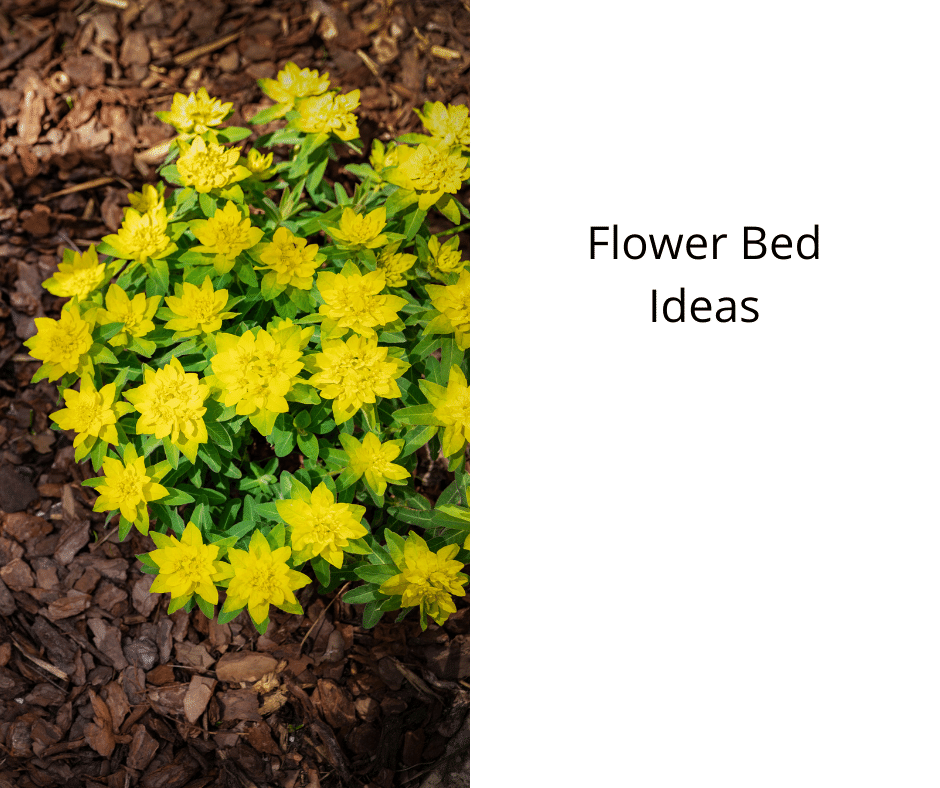
If you want to add a splash of color to your garden bed, there are various methods you can try. From planting tulips in a pot, to adding hydrangeas, succulents, and even a trellis, these ideas are simple to execute and will enhance the beauty of your flower bed.
Planting Tulips in Pots
Planting tulips in pots is a beautiful way to decorate your flower bed. They will last much longer than cut flowers and can be brought indoors to keep your room looking fresh. However, they will die once you cut them. Planting tulips in pots is a great alternative to planting them in the ground, and they look great in window boxes, too.
When planting tulips in pots, it is important to remember that the soil in your pot should have a drainage hole in it. This will help to keep your flowers from drowning in water. You can use Miracle-Gro Potting Mix to fill the pot.

In case your soil is heavy, mix some sand in it to make it lighter. You should then plant your bulbs four to six inches deep. The spacing between each bulb should be 4 inches (10 cm). You can also use bulb planters to make the process easier.
Tulips grow best in full sun. If your flower bed is shaded, plant them under a leafless tree. They are inexpensive and colorful, and blend in well with other spring flowers. Another bonus: tulips are edible! Planting tulips in pots is a great way to add color and interest to your flower bed.
Planting Hydrangeas
Hydrangeas are a great plant to incorporate into your flower bed ideas. They can be grown in large pots and are an eye-catching addition to your outdoor space. Plant them in early spring or fall to give them plenty of time to establish a robust root system. During the first spring, water them well to ensure they are correctly established.
Hydrangeas are an easy plant to grow. They are hardy in zones 3 to 9, and they can grow as large as 15 feet tall. Their flowering season varies depending on the variety, but most will bloom throughout the summer and into fall. The blooming time for hydrangeas varies by variety, but many varieties can tolerate full sun.

Hydrangeas can be pruned to make them look tidy. Pruning them does not require major surgery, but it will enhance their structure and allow them to breathe. You can choose to prune your hydrangeas in late spring or early summer, but keep in mind that pruning is only necessary for plants with a mature flower head.
If you are planting hydrangeas in flower bed ideas, you can buy a one-gallon shrub. This type of plant will have more extensive roots, which means it can establish itself quickly and have a dramatic impact. Alternatively, you can grow hydrangeas from seed. When starting a new plant, make sure that you cover it with a layer of soil and do not bury the seeds.
Planting Succulents
Before planting succulents, you should know about how to prepare the soil. Generally, succulents need at least six inches of specialized soil. You can add sand or organic material to improve drainage. The soil should have adequate space to grow roots and should be moist but not dry. This will help prevent weeds and conserve moisture.
Succulents need regular watering to keep them healthy and to grow well. However, you should make sure that they dry out between waterings, as it gives them breathing space. The frequency of watering will depend on the soil and weather conditions. Some varieties may go for weeks or months without water.
Planting succulents in containers is a great way to add color to any flower bed. They are small enough to fit into a small space and can colonize it quickly. Alternatively, you can plant them in cracks in concrete or brick. Echeverias and sempervivums are hardy plants and can even be planted in concrete.

Planting succulents in a flower bed requires a bit of planning. Start by choosing succulents that are easy to grow and maintain. For beginners, it’s best to go for easy-care, low-maintenance species, such as Sempervivum or Sedum. When arranging your succulents in a flower bed, try to place the tallest species in the center, and the smaller ones on the edges, or between larger plants.
Planting a Trellis
A trellis gives a flower bed a nice architectural touch. It also secures climbing plants and adds privacy. There are many different types of trellises. Some are made of wood, while others are made of metal. The trellis you choose depends on what you want to grow in your flower bed.
A simple trellis can be purchased for a fair price. A more elaborate one can be made with more time and effort. There are many types of trellises available, and you can choose from a number of classic and unusual designs. The classic style is simple but elegant, a square grid that looks perfect when vines cover the trellis. You can make a trellis using the right tools and measurements.

Another type of trellis is a triangular trellis. This trellis is useful for supporting annual vines. Plants that grow up the triangular structure have a tendency to grow horizontally.
Planting Grasses
Grassy flower beds can provide a beautiful backdrop for the flowering plants in your garden. You can plant several different types of grasses to create a variety of textures and colors. Most varieties are annuals, so you will not have to worry about transplanting or dividing them. In addition, few pests bother grasses. Most of them can be controlled with regular watering.
While grasses can be used in various ways, they are best suited for large areas. They can be used in combination with perennials to help define a border or to define spaces within a flower bed. There are even several varieties of grasses that grow in large mats.

Before planting grasses, be sure to choose a shady spot where the sun won’t burn them. Shaded areas can be perfect for Norther sea oats and black mondo. Tall grasses can also be planted in terracotta pots. You should also remove the old growth before planting. This will help new growth thrive in the spring.
Depending on the species, you can plant grasses in your flower beds during spring and autumn. Different grasses have different growing conditions and require different amounts of care. Some prefer moist soil while others prefer dry soil. Most grasses prefer full sun, though some can also tolerate partial shade. Some require periodic cutting and division during the spring.
Planting a Patterned Border
Planting a patterned border in flower bed can add visual interest to your flower bed. You can also mix up colors or plants and place them randomly around the border. It’s important to avoid creating distinct clumps of one color. Instead, use a mix of colors that will make the border more cohesive.
Consider using colorful perennials and annuals. They will brighten the border while also providing long-lasting color and a low cost. A solid-green groundcover will also help you keep the border from looking too busy. You can also use evergreen shrubs for their distinctive plant forms and color.
When planning the design for your border, remember that it’s not a difficult process. You should know the plant habits and flowering times of your chosen plants. You can then decide on a colour theme and fill in the gaps with matching plants as the season progresses.

A border needs periodic maintenance, and it’s important to embrace the fact that your border will change over time. Some species will disappear and others will grow. To keep the design fresh, you can do some minor maintenance in spring and fall. You can also weed the border or lift up rampant plants.
Planting Roses
One of the first steps when planting roses in a flower bed is determining the best spot for them. The best spots for roses are those that receive full sun most of the day. Roses in colder climates should be planted in partial shade during the afternoon. This will prevent blossoms from being scorched and help them last longer. It is important to keep the soil moist and free of weeds. Roses also need good air circulation and well-drained soil.

Roses should be planted in well-prepared soil that is slightly acidic. Soils with a pH of 6.5 are ideal for most roses. You can test the soil’s pH by using a soil test kit. If the soil is too acidic or alkaline, you can add sulfur or finely ground limestone to balance it. When planting bare-root roses, make sure that they are thoroughly wet before planting. The roots should remain moist for eight to 12 hours before planting. Once the roots have been prepared, dig a hole at least two inches deep and twice as wide as the root’s length.
After planting roses, keep an eye out for aphids and other pests. These insects feed on the leaves and flowers of roses. Luckily, most of these pests are easily controlled by neem oil or insecticidal soap. Roses that are susceptible to aphids can be protected by planting alliums around them.
- About the Author
- Latest Posts
Introducing Ron, the home decor aficionado at ByRetreat, whose passion for creating beautiful and inviting spaces is at the heart of his work. With his deep knowledge of home decor and his innate sense of style, Ron brings a wealth of expertise and a keen eye for detail to the ByRetreat team.
Ron’s love for home decor goes beyond aesthetics; he understands that our surroundings play a significant role in our overall well-being and productivity. With this in mind, Ron is dedicated to transforming remote workspaces into havens of comfort, functionality, and beauty.
Beginners Guides
The Best Fake Plants for Your Home – That Don’t Look Fake
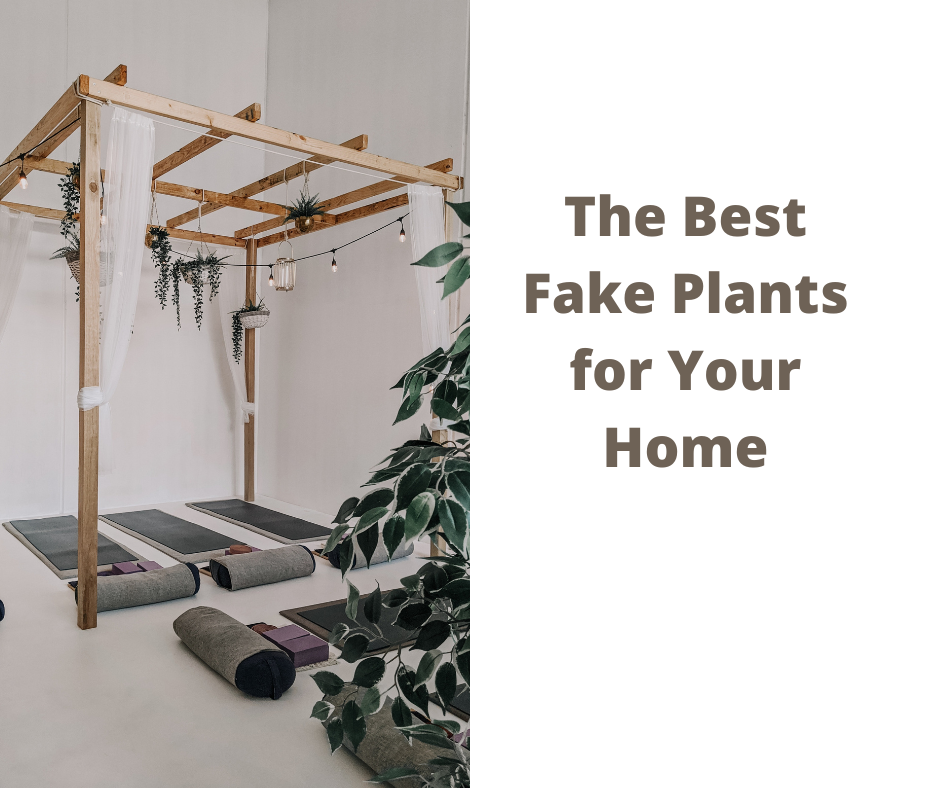
When it comes to bringing greenery into your home, there are two different perspectives. Some individuals insist on using real plants, while others are content with artificial ones. Each approach has its advantages and disadvantages, but if you decide to go with fake plants, it’s important to consider a few factors. Start by selecting a plant that suits the specific area where you intend to place it.
A plant thrives in low-light conditions and will not look very good in a sunny spot. Second, make sure the materials the plant is made from look realistic. Artificial plants made of plastic or silk are often quite obvious, while those made of more natural materials like wood or paper can be much more convincing. Finally, don’t forget to dust and clean your fake plants regularly. A little bit of upkeep will go a long way towards making them look their best.
Best Fake Plants
Are you looking for some new plants to add to your home décor but don’t want the hassle of taking care of them? Check out our list of the best fake plants! These artificial plants look so real that you’ll be surprised at how great they look in your home. Plus, they require no maintenance so that you can enjoy their beauty without fuss.
Fake Plants Are a Great Choice
Nothing like a touch of greenery brightens up a room, but keeping real plants alive can be challenging. Fake plants offer the beauty of the real thing without any hassle, and they’re becoming increasingly realistic. New technologies have made artificial plants look more lifelike than ever before, making them a great option for anyone who wants to add a touch of nature to their home without any work.

Fake plants are also incredibly versatile. They come in a wide range of styles and sizes, so it’s easy to find one that fits your décor. Best of all, they require no watering or maintenance so that you can enjoy them hassle-free. Whether you’re looking for a low-maintenance option or simply can’t keep real plants alive, fake plants are a great choice.
Best Overall – 6ft Artificial Fiddle Leaf Fig Tree (72in)
There’s no doubt about it, fiddle leaf fig trees are beautiful. But for those who don’t have a green thumb, caring for a living plant can be daunting.
[affiliatable id=’99536′] Thankfully, there are plenty of great faux options on the market, and the OXLLXO Artificial Fiddle Leaf Fig Tree is one of the most realistic-looking. The tree features a series of narrow trunks and thin branches dotted with lush leaves. These leaves are soft, and the branches are adjustable, so you can customize the tree to suit your space. Plus, there’s no need to worry about watering or fertilizing—just enjoy your beautiful tree!
Best Budget – Faux Plants Indoor
Updating your décor can be a fun way to refresh your space, but it can also be a costly undertaking. Consider opting for a faux plant if you’re looking for a dramatic update that won’t break the bank. Faux plants have come a long way recently, and many are incredibly realistic.
[affiliatable id=’99547′]
Nearly Natural’s Golden Cane Palm Silk Tree is a prime example. The plant is a whopping 6’6” tall, so it should make a statement in any room. And since its leaves are crafted from delicate silk, they look incredibly realistic. Plus, the tree comes in a stylish planter that will elevate your space. Whether you’re looking to add a touch of nature to your décor or simply want to make a bold statement, this faux plant is up to the task.
Forever Leaf has a great selection of affordable artificial plants if you’re looking for a way to add some green to your space without breaking the bank. Whether you’re looking for a small potted plant to spruce up your desk or a large floor plant to add some life to your living room, Forever Leaf has a wide variety of options.
And unlike real plants, these faux plants require no watering or maintenance so that you can enjoy their beauty without any hassles. So if you’re looking for an easy and budget-friendly way to add some greenery to your space, check out Forever Leaf.
Best Palm – Nearly Natural 6.5ft. Golden Cane Palm Silk Tree
The Nearly Natural 6.5ft. Golden Cane Palm Silk Tree is an elegant addition to any room. The palm tree is known for its ability to thrive in warm climates, and its beautiful golden leaves add a touch of luxury to any setting. The Nearly Natural 6.5ft. Golden Cane Palm Silk Tree is also remarkably easy to care for.
[affiliatable id=’99549′]
The faux tree is a beautiful addition to any home. With three narrow trunks and 333 palm leaves, it is incredibly realistic and easily the most lifelike of all the fake plants of its kind. I found it easy to move from room to room, and loved how it looked in her home. The pot is black, but if you’re looking for something with more flair, you can easily swap it out for something else. The tree weighs only 11 pounds, making it easy to transport. It is also very easy to assemble and looks great in any space. This is the one for you if you’re looking for a beautiful, realistic fake tree.
Unlike real palm trees, it doesn’t require regular pruning or watering, and it can be enjoyed for years with minimal upkeep. Whether you’re looking to add a touch of the tropics to your home or simply want an attractive and low-maintenance plant, the Nearly Natural 6.5ft. Golden Cane Palm Silk Tree is a perfect choice.
Best Monstera – Artificial Monstera Deliciosa Plant 37″
The Best Monstera – Artificial Monstera Deliciosa Plant is a replica of the real thing, down to the smallest detail. It stands 37″ tall and is made from high-quality materials, making it durable and long-lasting.
Monstera plants are a beautiful addition to any corner. This lifelike fake monstera deliciosa plant with superb detailing is the perfect substitute for a real tree because it mimics the natural branches, and foliage of a real thing.
[affiliatable id=’99565′]
To use this artificial tree for interior décor, you don’t have to worry about watering, trimming, or applying fertilizer. This makes it an ideal choice for people who want all the beauty of a real plant without any hassle. Whether you’re looking to add a touch of nature to your home or office, these plants are a perfect way to do it.
Best Orchid: White Realistic Artificial Phalaenopsis Orchids
Orchids are a beautiful, elegant addition to any home. They come in many different colors, but white orchids are particularly stunning. White Realistic Artificial Phalaenopsis Orchids are the best type of artificial orchids because they look real. The petals are made of a soft, silky material that looks just like real orchid petals. They also have realistic-looking leaves and stems.
These orchids come in various sizes to choose the perfect one for your home. You can also find them in different price ranges, depending on how many you want to buy. Whether you’re looking for a single orchid to add to a vase or an entire set to decorate your home, White Realistic Artificial Phalaenopsis Orchids are a perfect choice.
[affiliatable id=’99567′]
Thanks to their beautiful blooms and graceful stature, orchids are among the most popular houseplants. However, they can also be notoriously finicky, requiring precise watering and humidity levels to thrive. If you don’t have the time or patience to care for a real orchid, a faux option like The Faux Orchid Phalaenopsis is a great alternative.
This lifelike artificial plant features intricate details and realistic blooms that will fool even the most discerning eye. Best of all, it’s incredibly low-maintenance, requiring nothing more than an occasional dusting to keep it looking its best. So if you’re looking for an elegant houseplant that won’t require constant attention, The Faux Orchid Phalaenopsis is a perfect choice.
Best Succulents – 16 Pack Artificial Succulent Flocking Plants Unpotted Mini Fake Succulents Plant
If you’re looking for a low-maintenance way to add some greenery to your space, look no further than these artificial succulent plants. These picks are made of a soft, flocked material that looks realistic, yet is easy to care for.
[affiliatable id=’99556′]
Simply insert them into a planter of your choice and enjoy the look of a healthy succulent garden without hassle. These plants are versatile and can be used in various settings, from office cubicles to wedding centerpieces. So whether you’re looking to add a touch of nature to your decor or searching for an easy way to spruce up your space, these artificial succulent plants are the perfect solution.
These artificial succulents worked out great for the wreath I made for a customer. The succulents looked very realistic and I received many compliments from people who saw it. The succulents are usually quite costly, so this was a great deal. I’m picky about these things, but even up close, these looked real.
For a 14″ wreath, I required 2 orders of these succulents and some additional greenery. overall, I was very happy with this product.
Best Hanging Basket – Bougainvillea Hanging Basket Silk Plant
Hanging plants are a great way to add a splash of color to your home without taking up valuable floor space. This hanging basket plant from Nearly Natural is a beautiful option with a rich pink hue. The faux flowers and cascading vines look and feel surprisingly real, thanks to the brand’s horticulturist-approved design. Plus, there’s no need to worry about watering this plant— simply enjoy its fresh look without the hassle.
[affiliatable id=’99570′]
If you’re looking for a cascading bougainvillea that will make a statement, look no further than the Nearly Natural. Bougainvillea Hanging Basket Silk Plant.
This beautiful plant is crafted with South American bougainvillea and features three delicate pastel petals surrounded by a mix of tiny cream-colored flowers. The cascading vines extend gracefully around a traditional wicker planter, and the lush leaves complement the vibrant blooms.
Best Artificial Arrangement – aux Eucalyptus Plants in Rustic Rectangular Wood Planter Box
Looking for a beautiful and realistic faux eucalyptus plant to add to your décor? Look no further than our Faux Eucalyptus Plant in Rustic Rectangular Wood Planter Box! This wonderful arrangement comes with artificial eucalyptus plants in two-tone green color, nestled in a rustic wooden planter box.
The dusty look of the plants makes them appear more realistic, making them a wonderful tabletop decoration or floral centerpiece for any occasion.
[affiliatable id=’99573′]
This Faux Eucalyptus Greenery Arrangement is the perfect way to add a touch of nature to your home or office décor. The artificial leaves and branches are crafted with realistic detail, and the vibrant green color is sure to brighten any space.
The arrangement comes in a black plastic pot, making it easy to display on a table, desk, or shelf. It is a great gift for housewarming, weddings, and Mother’s Day. Whether looking for a beautiful centerpiece for your dining room table or a simple way to spruce up your office décor, this Faux Eucalyptus Greenery Arrangement is a perfect choice.
- About the Author
- Latest Posts
Meet Bethia, the visionary designer at ByRetreat who brings a touch of magic to every remote workspace she creates. With a boundless imagination and an eye for beauty, Bethia is passionate about transforming ordinary spaces into extraordinary havens of creativity and comfort.
Bethia possesses a unique talent for envisioning the perfect combination of furniture, colors, and textures that harmonize seamlessly in a room. She understands that selecting furniture goes beyond mere functionality; it’s about curating pieces that evoke a sense of style and sophistication while enhancing the overall ambiance.
Plants
Ideal Hydrangea Spots: Best Place to Plant Hydrangeas
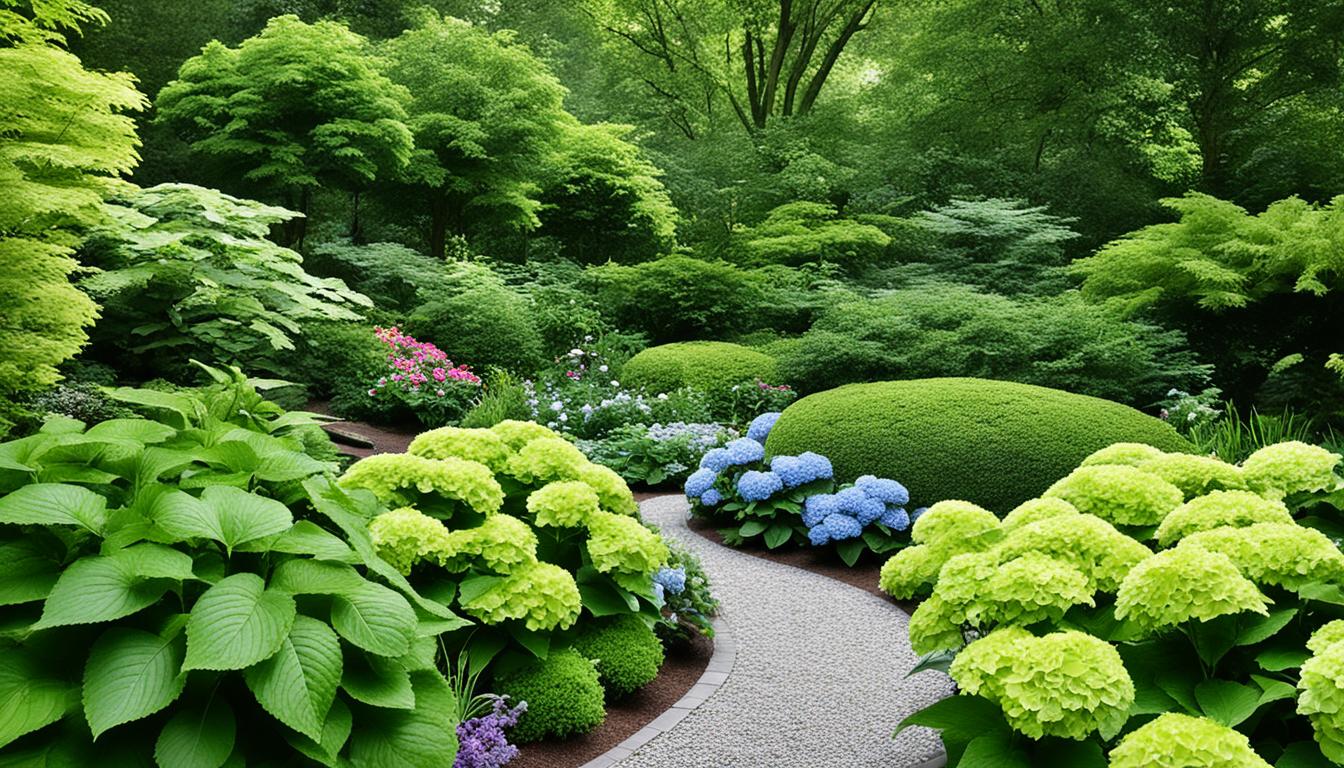
Did you know that the location where you plant your hydrangeas can have a significant impact on their growth and vibrancy? Finding the best place to plant hydrangeas is essential for optimal growth and to ensure that you get the most beautiful blooms.
In this guide, we will explore the different factors to consider when selecting the ideal spot for your hydrangeas. Whether you have a sunny garden or a shady corner, we’ll help you choose the right hydrangea varieties to thrive in various sun and shade conditions. By understanding their sunlight preferences and caring for them properly, you can enjoy vibrant and healthy hydrangea blooms year after year.
Key Takeaways:
- Choosing the right location is crucial for the growth and vibrancy of hydrangeas.
- Hydrangeas can thrive in different sunlight conditions, from full sun to partial shade.
- Consider the specific sunlight needs of different hydrangea varieties for optimal results.
- Proper care, including pruning, fertilizing, and watering, is essential for healthy blooms.
- By following our planting guide and care tips, you can transform your garden with stunning hydrangea displays.
Hydrangeas for Part Shade: Give Us Some Sunblock Please
When it comes to creating the perfect environment for hydrangeas, finding the right balance of sun and shade is key. While some hydrangea varieties thrive in full sun, others prefer a location with partial shade, where they can benefit from the morning sun and enjoy relief from the scorching afternoon rays. These hydrangeas are like beachgoers who know the importance of sunblock, seeking a little shade to protect themselves from the intense heat.
In the family of hydrangeas, there are several popular cultivars that are well-suited for part shade conditions. These varieties have the ability to produce stunning blooms when provided with a combination of filtered light and a few hours of full sun. Among them are the beloved Endless Summer® Hydrangea series, which includes BloomStruck®, Endless Summer®, Blushing Bride®, and Twist-n-Shout®.
Another great choice for morning sun and afternoon shade is the Annabelle Hydrangea, which is known for its spectacular large white flowers. And let’s not forget the many bigleaf hydrangea cultivars that can handle part shade and reward you with their vibrant blossoms.
Here are a few remarkable hydrangea varieties that thrive in part shade:
| Hydrangea Variety | Light Requirements |
|---|---|
| Endless Summer® series (BloomStruck®, Endless Summer®, Blushing Bride®, Twist-n-Shout®) | Morning sun, afternoon shade |
| Annabelle Hydrangea | Morning sun, afternoon shade |
| Bigleaf hydrangea cultivars | Morning sun, afternoon shade |
These hydrangeas have adapted to thrive in part shade by enjoying the gentle morning sun and being sheltered from the intense afternoon heat. This combination of light conditions allows them to produce their enchanting blooms and add a touch of elegance to any garden or landscape.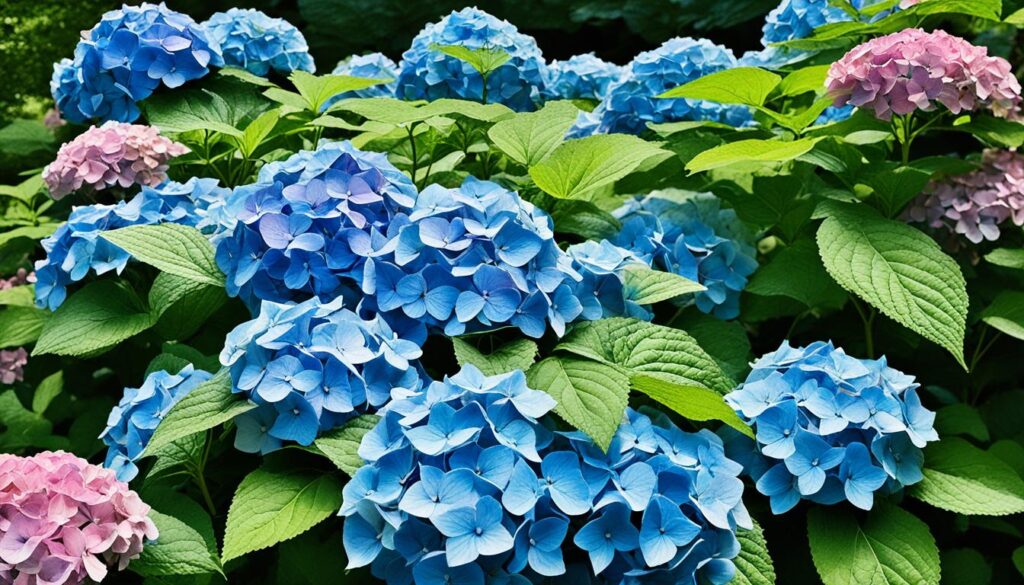
So, if you have a garden or yard with a mix of sunlight and shade, don’t worry! There are plenty of beautiful hydrangeas that will thrive in this environment. Just give them some sunblock (in the form of morning sun) and watch as their blooms light up your space with their breathtaking beauty.
Hydrangeas for Full Sun: We Like It Sunny
While most hydrangeas prefer some shade, there are certain varieties that can thrive in full sun. If your garden gets plenty of sunlight, don’t worry! There are hydrangeas that will flourish in these conditions and reward you with beautiful blooms.
Panicle Hydrangeas
Panicle hydrangeas, known for their cone-shaped flower clusters, are excellent choices for full sun exposure. They can tolerate the direct heat and intense sunlight, making them perfect for sunny spots in your garden. Some popular panicle hydrangeas include:
- Fire Light®
- Limelight
- Pinky Winky®
- Strawberry Sundae®
- Vanilla Strawberry®
Dwarf Varieties
If you have limited space or prefer compact hydrangeas, consider the Let’s Dance® and Cityline® series. These dwarf varieties are perfect for both full sun and part sun environments. They offer the beauty of hydrangeas in a smaller package without compromising on vibrant blooms.
Smooth Hydrangeas
Smooth hydrangeas are another type that can handle full or part sun conditions. These varieties are known for their large rounded flower heads and are a great choice for a sunny garden. Consider the following smooth hydrangeas:
- Incrediball®
- Invincibelle® Ruby
With these hydrangeas, you can enjoy the beauty and charm of these flowering plants even in full sun areas. Just make sure to provide them with proper care and maintenance, including regular watering and occasional fertilization.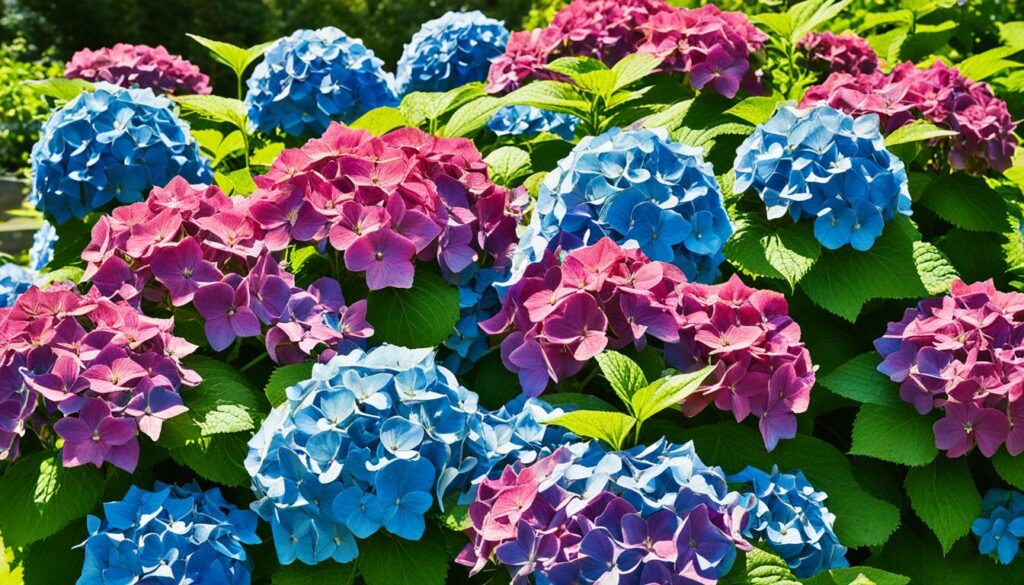
Overall, including hydrangeas that thrive in full sun can add a splash of color and vibrancy to your garden. Whether you choose panicle hydrangeas, dwarf varieties, or smooth hydrangeas, these sun-loving beauties will brighten up any sunny corner of your outdoor space.
Growing Hydrangeas in Different Sun and Shade Conditions
When it comes to growing hydrangeas, understanding their sunlight requirements is essential for their success. While many hydrangea varieties thrive in partial shade, oakleaf hydrangeas are known for their adaptability to different sun and shade conditions.
In the northern parts of the United States, oakleaf hydrangeas can tolerate full sun. However, in warmer and southern climates, they prefer some afternoon shade to protect them from excessive heat and sun exposure. This makes them an excellent choice for those looking to plant hydrangeas in regions with varying temperature and sunlight conditions.
What makes oakleaf hydrangeas unique is their ability to also tolerate full shade. This makes them ideal for areas of the garden that receive little to no direct sunlight. Whether it’s a densely shaded corner or underneath taller trees, oakleaf hydrangeas can thrive and add beauty to areas that are typically challenging for other hydrangea varieties.
It’s important to note that while oakleaf hydrangeas are the most adaptable, other hydrangea varieties have specific sunlight needs. When selecting the location for planting, it’s crucial to consider the specific requirements of each hydrangea type to ensure optimal growth and vigor.
By carefully assessing the sunlight conditions in your garden and selecting the appropriate hydrangea varieties, you can create a diverse and captivating display of hydrangeas that thrive in different sun and shade conditions.
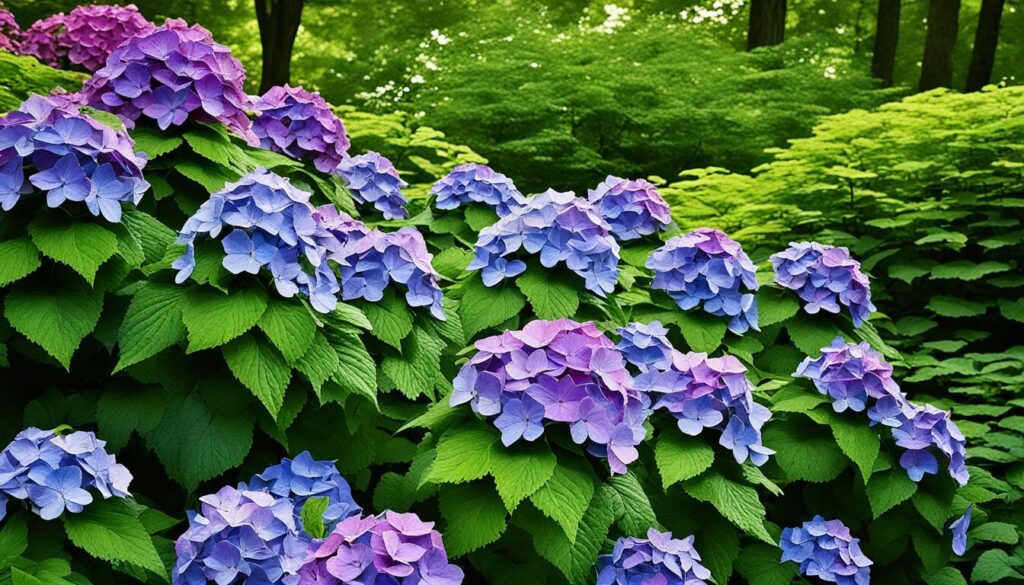
Pruning and Caring for Hydrangeas
Proper pruning and care are essential for the health and vitality of hydrangeas. By implementing appropriate pruning techniques and providing the necessary care, gardeners can ensure the longevity and abundant blooming of their hydrangea plants. Here are some important tips to consider:
Understanding Pruning Methods
When pruning hydrangeas, it’s crucial to understand whether the plant blooms on old wood or new wood. This knowledge will help gardeners avoid accidentally cutting off next season’s flowers.
Tip: Prune hydrangeas that bloom on old wood immediately after flowering. This allows for new growth and development of flower buds for next year. On the other hand, hydrangeas that bloom on new wood can be pruned during late winter or early spring before new growth begins.
Optimal Soil Conditions
Hydrangeas thrive in well-drained soil that is rich in organic matter. A mixture of compost and native soil is ideal for providing the necessary nutrients and moisture retention.
Fertilizing for Healthy Blooms
To promote healthy blooming, it’s recommended to fertilize hydrangeas with a slow-release fertilizer that is high in phosphorus. Phosphorus is essential for promoting flower production and overall plant vitality.
Preventing Leaf Scorch
Hydrangeas are susceptible to leaf scorch, especially during hot and dry periods. To prevent leaf scorch, it’s important to provide hydrangeas with extra water and ensure they have adequate moisture in the soil.
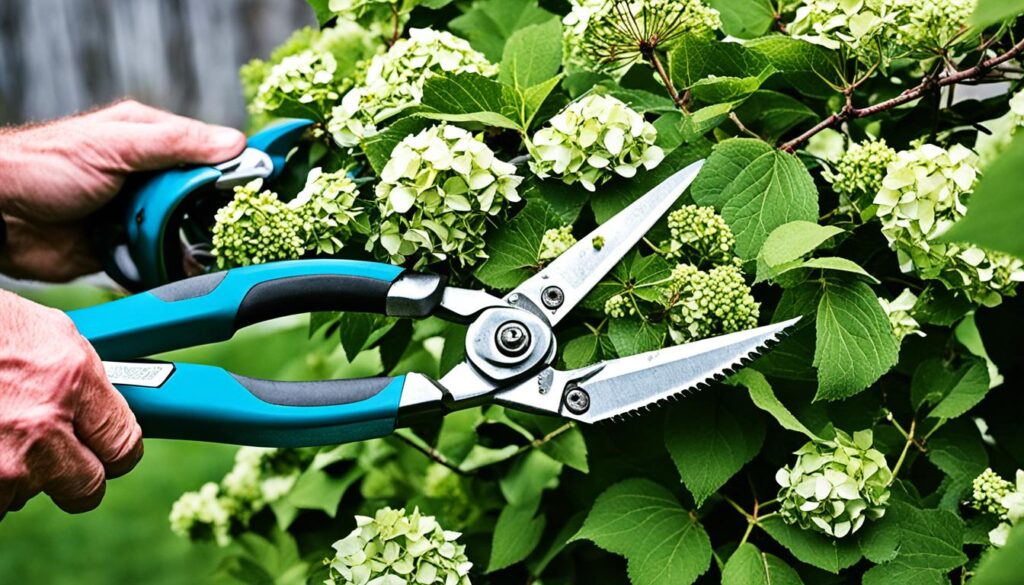
Summary of Pruning and Care Tips
| Pruning Method | Soil Conditions | Fertilizing | Preventing Leaf Scorch |
|---|---|---|---|
| Prune hydrangeas that bloom on old wood immediately after flowering | Well-drained soil with organic compost | Use slow-release fertilizer high in phosphorus | Provide extra water during hot and dry periods |
By following these pruning and care tips, hydrangea enthusiasts can enjoy lush, vibrant blooms year after year. With proper maintenance, these stunning plants will continue to beautify gardens and landscapes.
Conclusion
Planting hydrangeas in the best location and providing proper care and maintenance are key to achieving beautiful and vibrant blooms. By selecting the right spot that balances sun and shade, ensuring well-drained soil, and following recommended pruning and watering practices, gardeners can enjoy the full potential of their hydrangea plants. With the right planting and care, hydrangeas can transform any garden into a colorful and inviting space.FAQ
What is the best place to plant hydrangeas?
What are the best types of hydrangeas for morning sun and afternoon shade?
Can hydrangeas grow in full sun?
Which hydrangea varieties are best for full shade?
How should I prune and care for hydrangeas?
Are there any tips for planting and caring for hydrangeas?
- About the Author
- Latest Posts
Meet Katherine, the creative enthusiast at ByRetreat who infuses her boundless passion for design into every remote workspace she crafts. With an innate sense of creativity and an eye for unconventional beauty, Katherine brings a unique and inspiring perspective to the team.
Katherine’s love for design is infectious, and her ability to think outside the box sets her apart. She believes that true artistry lies in embracing a variety of styles and mixing them harmoniously to create captivating spaces. By combining different textures, colors, and patterns, Katherine weaves a tapestry of creativity that breathes life into each remote workspace.
-
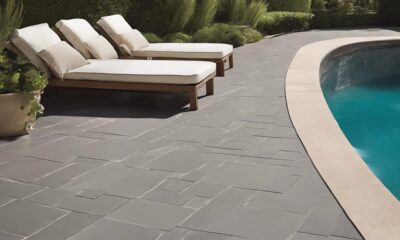
 Vetted9 hours ago
Vetted9 hours ago15 Best Tile Adhesives for Outdoor Use – Top Picks for Durable and Weather-Resistant Installations
-

 Vetted1 day ago
Vetted1 day ago15 Best Plants to Thrive on the North Side of Your House – A Gardener's Guide
-

 Vetted1 week ago
Vetted1 week ago15 Best Boxwood Varieties for Thriving in Full Sunlight
-

 Vetted2 weeks ago
Vetted2 weeks ago15 Best Ways to Label Clothes for Nursing Home Residents – Stay Organized and Efficient
-

 Decor3 days ago
Decor3 days agoAre Home Decor Stores Profitable?
-

 Vetted1 week ago
Vetted1 week ago15 Best Dryer Vent Hoses to Keep Your Laundry Room Safe and Efficient
-

 Vetted1 week ago
Vetted1 week ago14 Best Cleaners for Aluminum Surfaces – Shine Bright Like a Diamond
-

 Vetted1 week ago
Vetted1 week ago15 Best Spider Sprays to Keep Your Home Arachnid-Free













